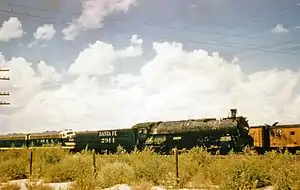Santa Fe Class 2900
The Santa Fe 2900 Class was a series of 30 4-8-4 Northern type steam locomotives built between 1943 and 1944 for Atchison, Topeka and Santa Fe Railroad and pulled freight and passenger trains until retirement in the mid to late 1950s.
| Atchison, Topeka & Santa Fe 2900 Class | |||||||||||||||||||||||||||||||||||||||||||
|---|---|---|---|---|---|---|---|---|---|---|---|---|---|---|---|---|---|---|---|---|---|---|---|---|---|---|---|---|---|---|---|---|---|---|---|---|---|---|---|---|---|---|---|
 Eastbound freight on the Santa Fe pulled by Santa Fe 2914 on August 22, 1952. | |||||||||||||||||||||||||||||||||||||||||||
| |||||||||||||||||||||||||||||||||||||||||||
| |||||||||||||||||||||||||||||||||||||||||||
| |||||||||||||||||||||||||||||||||||||||||||
| |||||||||||||||||||||||||||||||||||||||||||
Today, six 2900s survive, with most on static display and one, No. 2926, being restored to operating condition. Once fully restored, it will be the largest operating 4-8-4 Northern type steam locomotive in the United States.
History
Being built during World War II, wartime shortages of material resulted in ordinary metals being used for their construction. This resulted in the class being the heaviest Northerns ever built. They out-weighed their nearest rivals by over 2000 pounds. They have Timken roller bearing on all axles.[1]
Though they were designed to haul passenger trains, wartime exigencies required that they haul freight until the war ended. After the war, they hauled passenger trains such as the Scout and Grand Canyon Limited. After diesels took over, the class was retired by 1959.
Preservation
Six 2900s survived into preservation:
- 2903 is displayed at the Illinois Railway Museum in Union, Illinois.
- 2912 is displayed at the Pueblo Railway Museum in Pueblo, Colorado.
- 2913 is displayed at Riverview Park in Fort Madison, Iowa.
- 2921 is now displayed at the Modesto Amtrak Station in Modesto, California. The locomotive is no longer on display at Beard Brook Park.
- 2925 is displayed at the California State Railroad Museum in Sacramento, California.
- 2926 moved out from Coronado Park in Albuquerque, New Mexico in 1999 to the New Mexico Steam Locomotive and Railroad Historical Society, then moved out for rebuilding to operating condition. On October 1, 2007, No. 2926 has been added to the National Register of Historic Places.
Roster
| Number | Baldwin serial number | Date built | Disposition | Notes |
|---|---|---|---|---|
| 2900 | 69788 | 1943 | Sold for scrap. | |
| 2901 | 69789 | 1943 | Sold for scrap. | |
| 2902 | 69790 | 1943 | Sold for scrap. | |
| 2903 | 69791 | 1943 | On display at the Illinois Railway Museum in Union, Illinois. | |
| 2904 | 69792 | 1943 | Sold for scrap. | |
| 2905 | 69793 | 1943 | Sold for scrap. | |
| 2906 | 69794 | 1943 | Sold for scrap. | |
| 2907 | 69795 | 1943 | Sold for scrap. | |
| 2908 | 69796 | 1943 | Sold for scrap. | |
| 2909 | 69797 | 1943 | Sold for scrap. | |
| 2910 | 69798 | 1943 | Sold for scrap. | |
| 2911 | 69799 | 1943 | Sold for scrap. | |
| 2912 | 69801 | 1943 | On display in Pueblo, Colorado. | |
| 2913 | 69800 | 1944 | On display in Fort Madison, Iowa. | |
| 2914 | 69802 | 1944 | Sold for scrap. | |
| 2915 | 69803 | 1944 | Sold for scrap. | |
| 2916 | 69804 | 1944 | Sold for scrap. | |
| 2917 | 69805 | 1944 | Sold for scrap | |
| 2918 | 69806 | 1944 | Sold for scrap. | |
| 2919 | 69807 | 1944 | Sold for scrap. | |
| 2920 | 69808 | 1944 | Sold for scrap. | |
| 2921 | 69809 | 1944 | On display at the Amtrak Station in Modesto, California. | |
| 2922 | 69810 | 1944 | Sold for scrap. | |
| 2923 | 69811 | 1944 | Sold for scrap. | |
| 2924 | 69812 | 1944 | Sold for scrap. | |
| 2925 | 69813 | 1944 | On display at the California State Railroad Museum in Sacramento, California. | |
| 2926 | 69844 | March 1944 | Under restoration to operating condition in Albuquerque, New Mexico. | On the National Register of Historic Places |
| 2927 | 69815 | 1944 | Sold for scrap. | |
| 2928 | 69816 | 1944 | Sold for scrap. | |
| 2929 | 69817 | 1944 | Sold for scrap. | |